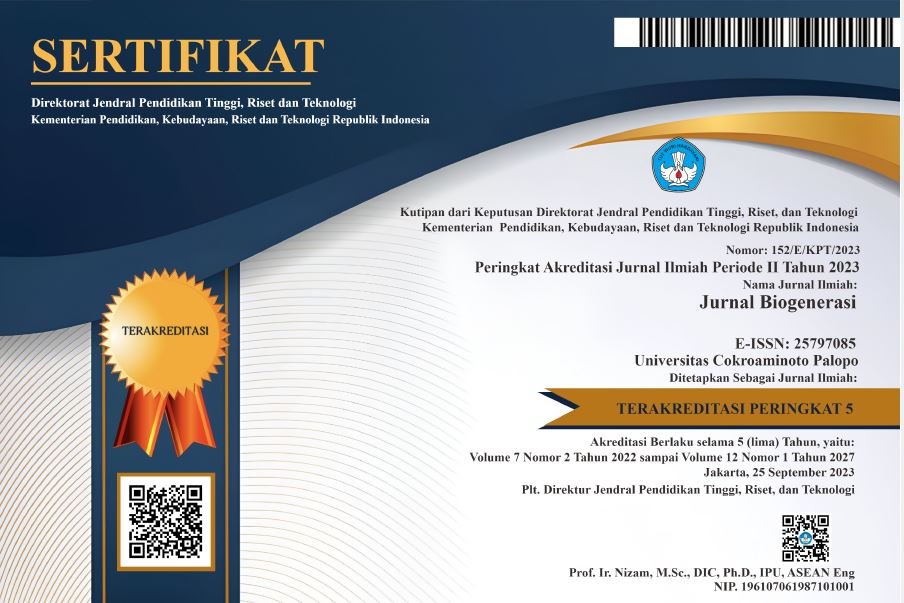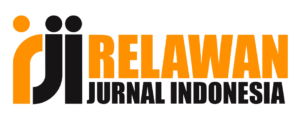Efektivitas Tanaman Genjer (Limnocharis flava) Sebagai Agen Fitoremediasi Penyerapan Fosfat Pada Air Limbah Laundry Di Kota Medan
DOI:
https://doi.org/10.30605/biogenerasi.v9i2.4754Keywords:
Limnocharis flava, phytoremediation, limbah laundryAbstract
This research aims to determine the effectiveness of the genjer plant (Limnocharis flava) in absorbing phosphate pollutants contained in laundry wastewater and to identify environmental factors that influence the effectiveness of the genjer plant (Limnocharis flava) in absorbing phosphate pollutants from laundry wastewater. The study was conducted in the Greenhouse of the Biology Department, Universitas Negeri Medan, using the constructed wetland method with variations in laundry wastewater concentrations (25%, 50%, 100%) and clean water as the control. The sample was taken from a laundry business on Jl. Tuasan, Medan City. Over 7 days of observation, parameters such as pH, temperature, turbidity, and the physical condition of the genjer plants were monitored. The results showed that genjer plants were effective in absorbing phosphate, with reduced turbidity and stabilized pH and temperature, with the 50% concentration treatment being the most optimal. This research is expected to serve as a reference for the application of phytoremediation technology using genjer plants (Limnocharis flava) as an environmentally friendly alternative for laundry wastewater treatment
Downloads
References
Amalia, S., Ghanaim, F., Umi, H., Mohammad, R. (2023). Efektifitas Limnocharis Flava Dan Hydrilla Verticillata Sebagai Fitoremediator Logam Tembaga. Alchemy: Journal Of Chemistry, 11(2), 43-50
Bahtiyar, A.Y (2018). Analisa Daya Penyerapan Genjer (Limnocharis Flava) Terhadap Kandunganlogam Berat Di Berbagai Media Air Tercemar. The 7thuniversity Research Colloqium 2018 STIKES PKU Muhammadiyah Surakarta.
Hartanti PI, Haji ATS, and Wirosoedarmo R, 2014. Pengaruh Kerapatan Tanaman Eceng Gondok (Eichornia Crassipes) Terhadap Penurunan Logam Chromium pada Limbah Cair Penyamakan Kulit. Jurnal Sumberdaya Alam dan Lingkungan; 1(2), 31-37.
Ikawati, S., Zulfikar, A., & Azizah, D. (2013). Efektivitas Dan Efisiensi Fitoremediasi Pada Deterjen Dengan Menggunakan Tanaman Genjer (Limnocharis flava) Fitoremediation Effectivity and Efficiency of Yellow velvetleaf (Limnocharis flava) for Detergent Orthophosphate. Jurnal Umrah, 1-7.
Koesputri, A. S., Nurjazuli, N., & Dangiran, H. L. (2016). Pengaruh Variasi Lama Kontak Tanaman Melati Air (Echinodorus Palaefolius) Dengan Sistem Subsurface Flow Wetlands Terhadap Penurunan Kadar Bod, Cod Dan Fosfat Dalam Limbah Cair Laundry. Jurnal Kesehatan Masyarakat, 4(4), 771-778.
Latuconsina, H. (2019). Ekologi perairan tropis: prinsip dasar pengelolaan sumber daya hayati perairan. UGM PRESS.
Nirmala, K., Wardani, S., Hastuti, Y. P., dan Nurussalam, W. (2016). Penentuan Bobot Kayu Apu Pistia stratiotes L. Sebagai Fitoremediator Dalam Pendederan Ikan Gurami Lac. Ukuran 3 Cm. Jurnal Akuakultur Indonesia, 15(2), 186.
Nisa, A.H., Firdaust, M., Purnomo, B.C. (2018). Deskripsi Kualitas Dan Kuantitas Limbah Cair Usaha Laundry Di Kelurahan Sumampir Kecamatan Purwokerto Utara Kabupaten Banyumas Tahun 2018. Keslingmas, 38(2), 124-243.
Novita, E., Wahyuningsih, S., Jannah, D. A. N., dan Pradana, H. A. (2020). Fitoremediasi Air Limbah Laboratorium Analitik Universitas Jember Dengan 27
Oktavia, Z., Budiyono, B., & Dewanti, N. A. Y. (2016). Pengaruh Variasi Lama Kontak Fitoremediasi Tanaman Kiambang (Salvinia Molesta) Terhadap Kadar Kadmium (Cd) Pada Limbah Cair Home Industry Batik “X” Magelang. Jurnal Kesehatan Masyarakat, 4(5), 238-245.
Novita, E., Wahyuningsih, S., Jannah, D. A. N., dan Pradana, H. A. (2020). Fitoremediasi Air Limbah Laboratorium Analitik Universitas Jember Dengan Pemanfaatan Tanaman Eceng Gondok dan Lembang. Jurnal Bioteknologi & Biosains Indonesia (JBBI), 7(1), 121–130.
Puspita, I.S. & Mirwan, M. (2021). Fitoremediasi Limbah Laundry Menggunakan Tanaman Mensiang (Actinoscirpus Grossus) Dan Lembang (Thypa angustifolia L.). Envirous Jurnal Teknik Lingkungan, 2(1)
Rahayuningtyas, I., Wahyuningsih, N. E., & Budiyono, B. (2018). Pengaruh Variasi Lama Waktu Kontak dan Berat Tanaman Apu-Apu (Pistia stratiotes L.) terhadap Kadar Timbal pada Irigasi Pertanian. Jurnal Kesehatan Masyarakat, 6(6), 166-174.
Ramadhani, A. C., Sitorus, R. J., Muslimin, M., Putri, R. N., & Ernia, R. (2023). Analisis Pengaruh Tanaman Melati Air sebagai Fitoremediasi dalam Mengatasi Pencemaran Air Limpasan Stockpile Batubara. Jurnal Ilmiah Universitas Batanghari Jambi, 23(2), 2050-2060.
Rusli, M. (2021). Merancang penelitian kualitatif dasar/deskriptif dan studi kasus. Al-Ubudiyah: Jurnal Pendidikan Dan Studi Islam, 2(1), 48-60.
Silviana, L., & Rachmadiarti, F. (2023). Fitoremediasi Fosfat dari Detergen Sintetis dengan Menggunakan Lemna minor dan Azolla microphylla. LenteraBio: Berkala Ilmiah Biologi, 12(3), 281-289.
Sukono, G, A., Farhan, H., Evitasari, Dodi, S. (2020). Mekanisme Fitoremediasi: Review. Jurnal Pengendalian Lingkungan, 2(2), 40-46.
Yuliana, Markus, H., Alfhons, D. (2020). Air Limbah Laundry: Karakteristik dan Pengaruhnya Terhadap Kualitas Air. Jurnal Natural, 16(1) : 25-33
Yusmidiarti. (2016). Analisis Pengelolaan Limbah Cair Usaha Laundry. Jurnal Media Kesehatan, 9(1), 001-113.
Zahra, F. (2022). Fitoremediasi Limbah Cair Domestik Menggunakan Genjer (Limnocharis flava) Dengan Sistem Hidroponik Rakit Apung (Doctoral dissertation, UIN Ar-Raniry).
Downloads
Published
How to Cite
Issue
Section
License
In submitting the manuscript to the journal, the authors certify that:
- They are authorized by their co-authors to enter into these arrangements.
- The work described has not been formally published before, except in the form of an abstract or as part of a published lecture, review, thesis, or overlay journal.
- That it is not under consideration for publication elsewhere,
- That its publication has been approved by all the author(s) and by the responsible authorities – tacitly or explicitly – of the institutes where the work has been carried out.
- They secure the right to reproduce any material that has already been published or copyrighted elsewhere.
- They agree to the following license and copyright agreement.
License and Copyright Agreement
Authors who publish with this journal agree to the following terms:
- Authors retain copyright and grant the journal right of first publication with the work simultaneously licensed under Creative Commons Attribution License (CC BY 4.0) that allows others to share the work with an acknowledgment of the work's authorship and initial publication in this journal.
- Authors are able to enter into separate, additional contractual arrangements for the non-exclusive distribution of the journal's published version of the work (e.g., post it to an institutional repository or publish it in a book), with an acknowledgment of its initial publication in this journal.
- Authors are permitted and encouraged to post their work online (e.g., in institutional repositories or on their website) prior to and during the submission process, as it can lead to productive exchanges, as well as earlier and greater citation of published work.


.png)

